Night sky, November 2024: What you can see tonight [maps]
Find out what's up in your night sky during November 2024 and how to see it in this Space.com stargazing guide.
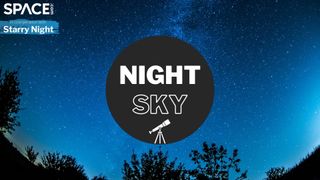
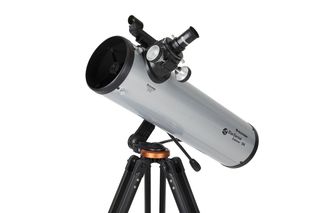
Looking for a telescope for the next night sky event? We recommend the Celestron StarSense Explorer DX 130AZ as the top pick for basic astrophotography in our best beginner's telescope guide.
The night sky tonight and on any clear night offers an ever-changing display of fascinating objects you can see, from stars and constellations to bright planets, the moon, and sometimes special events like meteor showers.
Observing the night sky can be done with no special equipment, although a sky map can be very useful, and a good telescope or binoculars will enhance some experiences and bring some otherwise invisible objects into view. You can also use astronomy accessories to make your observing easier, and use our Satellite Tracker page powered by N2YO.comto find out when and how to see the International Space Station and other satellites. We also have a helpful guide on how you can see and track a Starlink satellite train.
You can also capture the night sky by using any of the best cameras for astrophotography, along with a selection of the best lenses for astrophotography.
Read on to find out what's up in the night sky tonight (planets visible now, moon phases, observing highlights this month) plus other resources (skywatching terms, night sky observing tips and further reading)
Related: The brightest planets in November's night sky: How to see them (and when)
Monthly skywatching information is provided to Space.com by Chris Vaughan of Starry Night Education, the leader in space science curriculum solutions. Follow Starry Night on Twitter @StarryNightEdu and Chris at @Astrogeoguy
Editor's note: If you have an amazing skywatching photo and would like to share them with Space.com's readers, send your photo(s), comments, and your name and location to spacephotos@space.com.
Calendar of observing highlights
Friday, Nov. 1: New Moon
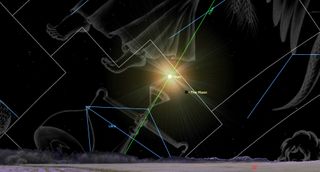
The moon will reach its new phase on Friday, Nov. 1 at 8:47 a.m. EDT, 5:47 a.m. PDT, or 12:47 GMT. At that time our natural satellite will be located in western Libra and 3.5 degrees south of the sun. While new, the moon is traveling between Earth and the sun. Since sunlight can only reach the far side of the moon, and the moon is in the same region of the sky as the sun, the moon becomes unobservable from anywhere on Earth for about a day (except during a solar eclipse). On the evenings following the new moon phase, our planet's partner will return to shine in the western sky after sunset.
Sunday, Nov. 3: Daylight Saving Time ends
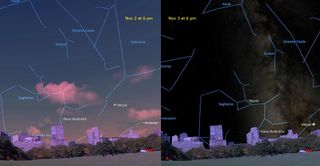
For jurisdictions that adopt Daylight Saving Time (DST), clocks should be set backward by one hour at 2 a.m. local time on Sunday, Nov. 3. After Sunday at mid-northern latitudes, the morning sky will be brighter for your commute to school or work and the moon and stars will be shining by dinner time, allowing the youngest astronomers to have some telescope time. Daylight Saving Time will resume on March 9, 2025.
Sunday, Nov. 3: Crescent moon, a star, and planets
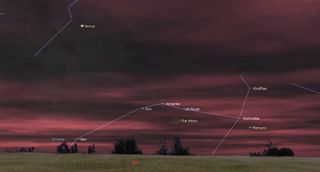
Search just above the southwestern horizon for a short period after sunset on Sunday, Nov. 3, to see the slim crescent of the young moon positioned a generous palm's width to the left (or 7 degrees to the celestial southeast) of the small dot of Mercury. Much brighter Venus will gleam off to their upper left. Observers located closer to the tropics, where the ecliptic will be more vertical, will see the moon and the planets more easily. As the sky darkens the fainter, but prominent star Antares, which marks the heart of the Scorpion, will appear just to the upper left of the moon.
Monday, Nov. 4: Earthshine moon under Venus
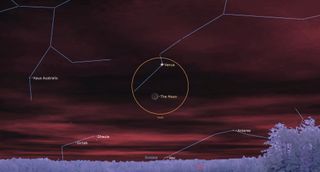
After 24 hours of orbital motion, the pretty crescent moon will hop east to shine several finger widths below (or celestial south of) Venus on Monday, Nov. 4. Look for the pair in the lower part of the southwestern sky immediately after sunset. They will be close enough to share the view in binoculars (orange circle) and will make a lovely widefield photograph. Take note of Earthshine, also known as the Ashen Glow and "the old moon in the new moon's arms". That's sunlight reflected off Earth and back onto the moon, slightly brightening the dark portion of the moon's Earth-facing hemisphere. The phenomenon appears for several days after each new moon.
Monday, Nov. 4: Southern Taurid meteor shower peak (late evening)
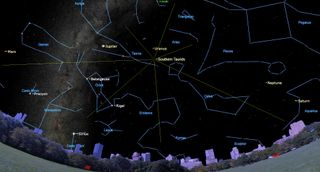
The Southern Taurid meteor shower, which is active worldwide from Sept. 28 to Dec. 8 annually, will reach its maximum rate of about 5 meteors per hour on Monday night, Nov. 4. Some meteors will appear once the sky darkens on Monday evening, but the best viewing time in the Americas will be around midnight when the radiant in western Taurus will be highest in the sky. Taurid meteors, which can appear anywhere in the sky, will be traveling away from a point in western Taurus. The long-lasting, weak shower is the first of two consecutive showers derived from debris dropped by the passage of periodic Comet 2P/Encke. The larger-than-average grain sizes of the comet's debris often produce colorful fireballs. This year, an early-setting moon will not affect the shower, though the bright planet Jupiter will shine near the radiant all night long.
Wednesday, Nov. 6: Lunar craters Theophilus, Cyrillus, and Catharina
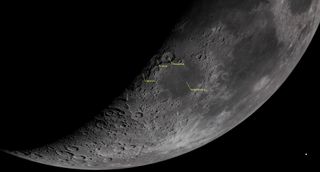
On Wednesday evening, Nov. 6, the terminator boundary between the moon's lit and dark hemispheres will fall just to the left of a trio of large craters named Theophilus, Cyrillus, and Catharina that curve along the western edge of gray Mare Nectaris. You can tell what order the craters were formed in by observing how sharp and fresh Theophilus' rim appears, and by the way it has partially overprinted neighboring Cyrillus to its lower left (or lunar southwest). Under magnification, Theophilus' terraced rim and craggy central mountain peak are evident. Cyrillus hosts a trio of degraded central peaks inside a hexagonal rim, while much older Catharina's peak has been submerged, her edges blurred and her floor overprinted by smaller, more recent craters.
Saturday, Nov. 9: First Quarter Moon
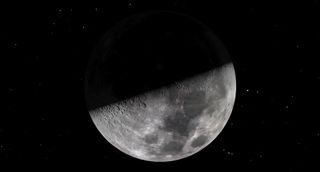
The moon will complete the first quarter of its 29.53-day trip around Earth on Saturday morning, Nov. 9 at 12:55 a.m. EST or 05:55 GMT, which converts to 9:55 p.m. PST on Friday evening. Lunar phases occur independently of Earth's rotation. First quarter moons always rise around mid-day and set around midnight, so they are also visible in the afternoon daytime sky.
At first quarter, the moon's 90-degree angle from the sun causes us to see it half-illuminated on its eastern side. The evenings surrounding first quarter are the best ones for seeing the lunar terrain when it is dramatically lit by low-angled sunlight, especially along the terminator, the pole-to-pole boundary that separates the moon's lit and dark hemispheres.
Sunday, Nov. 10: Moon approaches Saturn
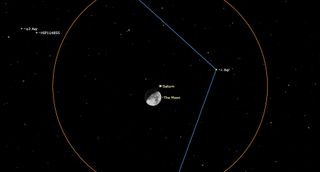
On Sunday, Nov. 10, the waxing gibbous moon will climb the southeastern sky all afternoon. Once the sky begins to darken after sunset, face south and look for the prominent, yellowish dot of Saturn close enough to the moon for them to share the view in binoculars (orange circle). Later that evening, observers located in a broad zone extending from the Atlantic Ocean and southwest across southern Florida, the Caribbean, Central America, and northwestern South America can see the moon occult Saturn with unaided eyes, binoculars, and backyard telescopes. Surrounding regions will see the moon merely pass close to Saturn. Use an app like Starry Night to look up the occultation times for your location.
Monday, Nov. 11: Northern Taurids Meteor Shower Peak (all night)
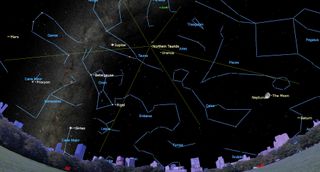
The Northern Taurids meteor shower, which is active worldwide from Oct. 20 to Dec. 10 annually, will reach its maximum overnight on Monday, Nov. 11 in the Americas. The best viewing time for North American skywatchers will be the hours around midnight when the shower's radiant near the Pleiades star cluster in Taurus will be well above the horizon, especially after the bright moon sets around 2:30 a.m. local time on Tuesday. The long-lasting, weak shower is the second of two consecutive showers derived from debris dropped by the passage of periodic Comet 2P/Encke. The Northern Taurids shower typically delivers 5 meteors per hour at its peak. The larger-than-average grain sizes of the particles often produce colorful fireballs.
Tuesday, Nov. 12: Inner planets prance in the west
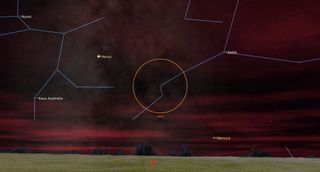
During mid-November, the inner planets Venus and Mercury will both shine in the southwestern sky after sunset. Mercury will be positioned less than two fist diameters to the lower right (or 18 degrees to the celestial west) of Venus and will set only an hour after the sun. Far brighter Venus will linger for more than an hour longer.
Wednesday, Nov. 13: The Aristarchus Plateau (all night)
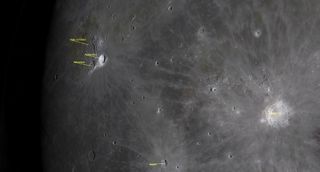
Three prominent craters break up the expanse of Oceanus Procellarum, the widespread dark region on the moon's left-hand side. Large Copernicus is the easternmost of the craters. Its extensive, ragged ray system intermingles with that of the smaller crater Kepler to its southwest. The very bright crater Aristarchus positioned northwest of them occupies the southeastern corner of a diamond-shaped plateau that is one of the most colorful regions on the moon. NASA orbiters have detected high levels of radioactive radon there.
Use a telescope and high magnification to view features like the large, sinuous rille named Vallis Schröteri. Its snake-like form begins between Aristarchus and next-door Herodotus and meanders across the plateau.
Thursday, Nov. 14: Bright lunar ray systems (all night)
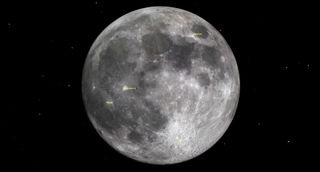
While the moon is near its full phase, bright rays can be seen radiating from the younger craters on the lunar near side. The impact that created the bright crater Tycho, which is located in the south-central area of the moon, produced streaks of bright material that extend in multiple directions across the moon's near side.
Another particularly interesting ray system surrounds the crater Proclus. The 16-mile (27 km) wide crater and its ray system are visible in binoculars. They are located at the lower left edge of Mare Crisium, the round grey basin near the moon's upper right edge (northeast on the moon). The Proclus rays, about 370 miles (600 km) in length, only appear on the eastern, right-hand side of the crater, and within Mare Crisium, suggesting that the impactor arrived at a shallow angle from the southwest. The small crater Menelaus on the southern edge of Mare Serenitatis hosts some small rays. A long, possibly unrelated, ray passes through both Menelaus and the mare. (Note that east and west are reversed on the moon).
Friday, Nov. 15: Full frost supermoon
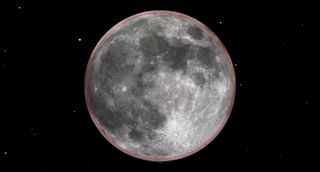
The November Full Moon, traditionally known as the Beaver Moon or Frost Moon, always shines within or near the stars of Taurus and Aries. The moon will reach its full phase at 4:29 p.m. EST, 1:29 p.m. PST, or 21:29 GMT on Friday, Nov. 15 but local moon rise times will vary depending on your location.
Indigenous groups have their own names for the full moons, which lit the way of the hunter or traveler at night before modern conveniences like flashlights. The Anishinaabe people of the Great Lakes region call this one Mnidoons Giizis Oonhg, the "Little Spirit Moon", a time of healing. The Cree Nation of central Canada calls it Kaskatinowipisim, the "Rivers Freeze-up Moon", when the lakes and rivers start to freeze. The Haudenosaunee Confederacy (Iroquois / Mohawk) of Eastern North America call it Kentenhko:wa, the "Time of Much Poverty Moon".
Full moons that occur during the cold months in North America will climb as high in the sky as the summer noonday sun, and cast similar shadows. Since the moon passed perigee 1.4 days ago, this will also be the last of four consecutive supermoons in 2024, appearing about 6% larger and 16% brighter than an average full moon (as shown by the red circle).
Friday, Nov. 15: Saturn stops reversing

On Saturday night, Nov. 15, Saturn's westward retrograde motion through the stars of central Aquarius will slow to a stop as it completes a retrograde loop that it began in July. Saturn's magnitude 0.9, yellowish dot will appear in the lower part of the southeastern sky at dusk, climb to its highest point due south at 7:15 p.m. local time, and then set in the west around 12:30 a.m.
Retrograde loops occur when Earth, on a faster orbit closer to the sun, passes more distant solar system objects "on the inside track", making them appear to move backwards across the stars for a while. Saturn's loop covered about a palm's width, or 6 degrees of the celestial sphere.
Saturday, Nov. 16: Mercury at greatest eastern elongation
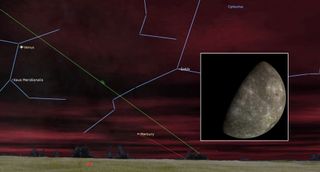
On Saturday, Nov. 16, Mercury (orbit shown in red) will reach its widest separation of 23 degrees east of the sun and maximum visibility for its current evening apparition. With Mercury positioned well below (i.e., south of) the tilted evening ecliptic (green line) in the southwestern sky, this appearance of the planet will be a poor one for Northern Hemisphere observers, but a very good showing from the tropics and the Southern Hemisphere.
The optimal viewing times at mid-northern latitudes will start around 5 p.m. local time. Viewed in a telescope (inset) the planet will exhibit a waning, slightly gibbous phase. The much brighter planet Venus will shine some distance to Mercury's upper left (or celestial east).
Saturday, Nov. 16: Uranus at opposition (all night)
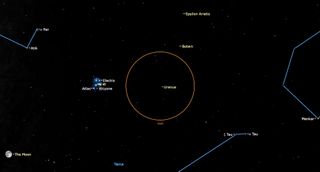
On Saturday, Nov. 16 Uranus will reach opposition, the night of the year when it is closest to Earth. Today Uranus will be at a distance of 1.74 billion miles, 2.78 billion km, or 154 light-minutes, and will shine at a peak brightness of magnitude 5.61 as it crosses the sky all night long, making it readily visible in binoculars and backyard telescopes.
Uranus' small, blue-green dot will also appear slightly larger in telescopes for about a week centered on opposition night. Uranus has been moving slowly retrograde westwards through western Taurus. This month, it will be positioned about a palm's width to the right (or 6.5 degrees to the celestial southwest) of the Pleiades Star Cluster aka Messier 45. If you use your binoculars (orange circle) to find the medium-bright stars named Botein and Epsilon Arietis, Uranus will be the dull-looking blue-green "star" located several finger widths below (southeast of) them. To see the planet more easily, wait a few nights for the bright moon to move away from Uranus.
Saturday, Nov. 16: Bright moon joins Jupiter (all night)
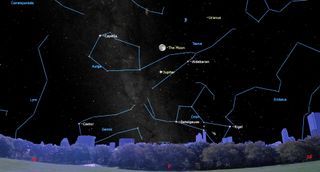
In the eastern sky after dusk on Saturday, Nov. 16, the very bright, gibbous moon will shine near the brilliant planet Jupiter. The pair will climb to their highest position in the southern sky after midnight and then descend in the west as sunrise approaches. By then the diurnal rotation of the sky will shift Jupiter to the moon's left. The gigantic winter hexagon asterism, a ring composed of the brightest stars in the winter constellations of Taurus, Auriga, Gemini, Canis Minor, Canis Major, and Orion, will surround Jupiter this winter.
Sunday, Nov. 17: Leonid Meteor Shower peaks (pre-dawn)
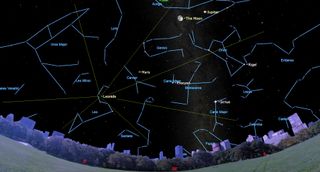
The annual Leonid Meteor shower, derived from material left by repeated passages of periodic Comet 55P/Tempel-Tuttle, is active from Nov. 6 to 30. The peak of the shower, when up to 15 meteors per hour are predicted, will occur from Saturday night, Nov. 16 into Sunday morning, Nov. 17 in the Americas, when Earth will be traversing the densest part of the comet's debris train. While you should see a few Leonids after dusk on Saturday evening — many with persistent trains — more of them will be apparent on Sunday in the hours before dawn when the radiant in the head of Leo will be high in the southeastern sky. Unfortunately, a bright moon will shine all night long during this year's shower, obscuring the fainter meteors.
Tuesday, Nov. 19: Moon near the twins (all night)
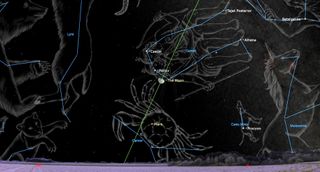
When the waning gibbous moon rises over the eastern treetops on Tuesday evening, Nov. 19, it will be positioned a short distance below (or southeast of) the bright golden star Pollux, which marks the head of Gemini's eastern twin. The slightly fainter and whiter double star Castor will shine above them. Bright reddish Mars will be located well below the moon. Our natural satellite shifts east by about its own diameter every hour (green line), so observers viewing the scene later or in more westerly time zones will see the moon farther from Pollux and closer to Mars. The diurnal rotation of the sky will also pivot their line to horizontal for early risers viewing them high in the west at dawn on Wednesday.
Wednesday, Nov. 20: Moon meets Mars and the bees (all night)
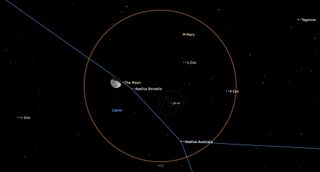
After 24 hours of additional motion, the waning gibbous moon will drop lower and shine several finger-widths to the lower left (or celestial east) of Mars on Wednesday evening, Nov. 20. The moon and Mars will be close enough for them to share the view in binoculars (orange circle). Binoculars should also reveal a large collection of stars scattered below Mars — the open star cluster in Cancer known as Messier 44 or the Beehive. To better see the "bees", which cover an area more than twice the moon's diameter, hide the moon out of sight beyond the left edge of your binoculars.
Thursday, Nov. 21: Moonlight tolerant stars
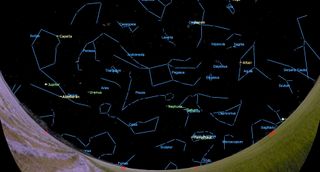
Only the brightest stars are visible to our unaided eyes on moonlight-flooded nights. Early on Thursday evening, Nov. 21, the very bright star Vega in the constellation of Lyra the Harp will be descending the western sky. At magnitude 0.0, it's the 5th brightest star in the sky (not counting our sun). The star Altair in Aquila the Eagle shining several fist diameters to Vega's left has a magnitude value of 0.75, making it the 13th brightest star. Deneb in Cygnus the Swan will be located above and between the other two, rounding out the trio of hot white stars that form the Summer Triangle asterism. At magnitude 1.25, Deneb ranks 20th in brightness.
Observers with a very low southwestern horizon might be able to see Fomalhaut, ranked 18th, in Piscis Austrinus the Southern Fish. Over in the east, very bright yellowish Capella (ranked 6th) in Auriga will be shining to the upper left of reddish Aldebaran (ranked 14th), marking the eye of Taurus the Bull.
Friday, Nov. 22: The double cluster
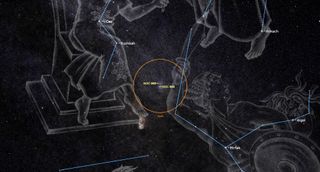
The northeastern sky on November evenings hosts the bright constellations of Perseus and W-shaped Cassiopeia, with the very bright star Capella positioned well below them. The sky between Perseus and Cassiopeia hosts the Double Cluster, a pair of bright open star clusters that together cover a finger's width of the sky. They make a spectacular sight in binoculars (orange circle) or a telescope at low magnification.
The higher (more westerly) cluster, designated NGC 869, is dense and contains more than 200 white and blue-white stars. The lower (easterly) cluster NGC 884 is looser and includes a handful of 8th-magnitude golden stars. The clusters, which both formed in the same part of the Perseus Arm of the Milky Way galaxy, are about 7,300 light-years away from us. The clusters would be even brighter if they weren't being dimmed by opaque dust in the galactic plane.
Friday, Nov. 22: Saturday, Nov. 23 - Third Quarter Moon
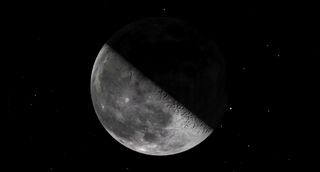
The moon will complete three-quarters of its orbit around Earth, measured from the previous new moon, on Friday, Nov. 22 at 8:28 p.m. EST (5.28 p.m. PST or 0128 GMT on Saturday, Nov. 23). At its third (or last) quarter phase, the moon is half-illuminated, on its western, sunward side. It will rise around midnight local time, and then remain visible until it sets in the western daytime sky in early afternoon. Third quarter moons are positioned ahead of the Earth in our trip around the sun. About 3½ hours later, Earth will occupy that same location in space. The week of dark, moonless evening skies that follow this phase are the best ones for observing fainter deep sky targets.
Wednesday, Nov. 27: Crescent moon covers Spica (pre-dawn)
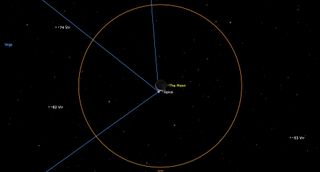
For observers located in a zone covering most of the eastern continental USA and Canada, the old, waning crescent moon will pass in front of (or occult) Virgo's brightest star, Spica shortly after it has cleared the trees in the east on Wednesday morning, Nov. 27 before sunrise. Use an app like Starry Night to look up the times for the occultation. In New York City, Spica will disappear behind the moon's lit crescent at about 5:35 a.m. EST. The star will pop into view from behind the dark limb of the moon in a brightening sky around 6:50 a.m. EST. Lunar occultations are safe to view you're your unaided eyes. Binoculars (orange circle) or any size of telescope will show it best. Start watching a few minutes before each stage of the event.
Thursday, Nov. 28: Medusa's eye pulses (at 6:03 p.m. EST)
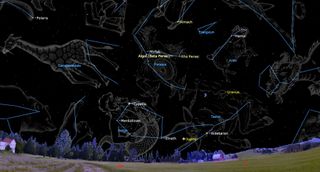
The star Algol in the constellation of Perseus represents the glowing eye of Medusa from Greek mythology. Also designated Beta Persei, it is among the most accessible variable stars for skywatchers. During a ten-hour period that repeats like clockwork every 2 days, 20 hours, and 49 minutes, Algol dims noticeably and re-brightens by about a third when a fainter companion star with an orbit nearly edge-on to Earth crosses in front of its much brighter primary, reducing the total light output we perceive. Algol normally shines at magnitude 2.1, similar to the nearby star Almach (aka Gamma Andromedae). But while fully dimmed, Algol's brightness of magnitude 3.4 is almost identical to Rho Persei (or Gorgonea Tertia or ρ Per), the star sitting just two finger widths to Algol's lower right (or 2.25 degrees to the celestial south). On Thursday evening, Nov. 28 at 6:03 p.m. EST or 23:03 GMT, Algol will be at its minimum brightness. At that time it will be located one-third of the way up the east-northeastern sky. Five hours later the star will return to full intensity from a perch nearly overhead. Observers in more westerly time zones can see the latter stages of the brightening.
Saturday, Nov. 30: Mars nears the Beehive (overnight)
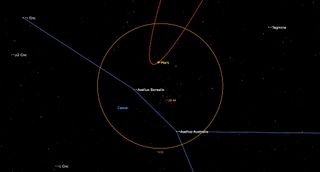
As November comes to a close, the eastward orbital motion of Mars will be carrying the red planet towards the large open star cluster in Cancer known as the Beehive, Praesepe, and Messier 44. The cluster spans an area more than twice the size of the full moon. Mars and its scattered stars will easily share the field of view in binoculars (orange circle). In early December, Mars will slow to a stop and commence a westward retrograde loop (red path) that will keep the planet near the Beehive cluster until the last week of December, giving imagers plenty of time to photograph the duo.
Visible planets in November
Mercury
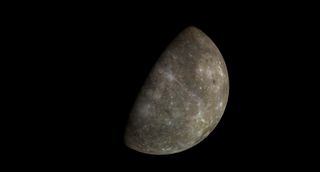
During November, Mercury will join brilliant Venus in the west after sunset, but the shallow slope of the ecliptic will keep the innermost planet pinned just above the west-southwestern horizon for observers at mid-northern latitudes. Mercury will shine higher and in a darker sky for observers in the tropics and farther south. The planet will shine at magnitude -0.3 until it reaches its maximum angle 23 degrees east of the sun on Nov. 16, and then it will rapidly fade in brightness and drop sunward. Views in a telescope during the month will show a disk that swells from 5.3 to 9.4 arc seconds while its illuminated phase decreases from a gibbous 85% to just 10%. The very slim waxing crescent moon will hop past Mercury on Nov. 2 and 3.
Venus
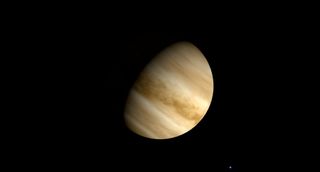
Venus will spend November increasing its angle from the sun from 38 to 43 degrees while it brightens slightly beyond magnitude -4.0. The shallow angle of the ecliptic after sunset will keep the brilliant planet somewhat low in the southwestern sky for mid-northern latitude observers, but Venus will offer its best appearance in 8 years for observers at southern latitudes. Our sister planet will set late enough for the surrounding stars to appear. It will depart Ophiuchus for Sagittarius on Nov. 9. Venus' passage through the Milky Way will carry it close to several deep sky objects, particularly the bright globular clusters Messier 19 on Nov. 1, Messier 28 on Nov. 16, Messier 22 on Nov. 18. Telescope views of Venus will in November will show a waning, slightly gibbous phase on a disk that grows in apparent size from 14.3 to 17.1 arc-seconds across over the course of the month. A lovely, young crescent moon will shine below (or celestial SSW of) Venus on Nov. 4.
Mars
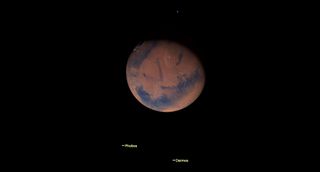
Mars will begin November rising with the stars of Cancer in the late evening and then climbing high in the southwest by sunrise. By the end of the month, it will be well-placed for observations anytime after mid-evening. Meanwhile, the planet will reduce its distance from Earth, increasing its brightness from magnitude +0.1 to -0.5 and growing in apparent size from 9.3 to 11.7 arc-seconds. Mars will slow its eastward motion over the month in preparation for a winter retrograde loop. That will move the planet to less than 2 degrees northwest of the Beehive Cluster on Nov. 30. In a telescope, Mars will display a 90%-illuminated, waxing gibbous phase on a ruddy-colored disk that grows in size from 9.3 to 11.6 arc-seconds. It will be joined by the waning gibbous moon on Nov. 20.
Jupiter
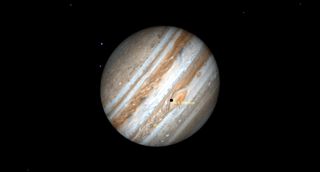
Brilliant, white Jupiter will shine all night long during November, rising at about 8 p.m. on Nov. 1 and by 7 p.m. at month's end. Early risers will see the bright planet descending the western sky before sunrise every morning. Jupiter's retrograde motion will cause it to drift west between the horns of Taurus and reduce its separation from the bright, orange star Aldebaran. Meanwhile, the brightest stars of winter will encircle the planet. Visually, Jupiter will shine at magnitude -2.7. Binoculars will reveal Jupiter's four large Galilean moons flanking the planet. A backyard telescope will show its equatorial bands on a disk that will grow from 46.2 to 48.2 arc-seconds, while a better quality instrument will reveal the Great Red Spot every 2nd or 3rd night, Jupiter's Galilean satellites frequently eclipsing and occulting one another, and times when they cast their round, black shadows on the planet. The bright, waning gibbous moon will hop past Jupiter on Nov. 16-17.
Saturn
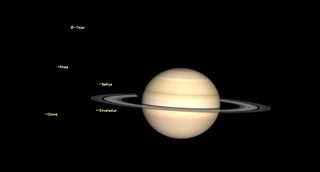
Saturn will be nicely positioned for evening viewing during November since it will be culminating due south after dusk. Its retrograde motion westward through the stars of eastern Aquarius will slow to a stop on Nov. 16, and then the ringed planet will resume its regular eastward motion. Viewed in a telescope, Saturn will show an apparent disk diameter of about 18 arc-seconds, and its rings will subtend 42 arc-seconds. The wedge of shadow that its globe casts upon its rings will be growing steadily. Saturn's rings will be tilted by a mere 3 degrees and will become even more edge-on to Earth until the spring of 2025. Saturn's moons will travel near the ring plane this year, allowing you to see their transits and their tiny black shadows across Saturn's globe — sometimes in pairs — through high-quality telescopes. The waxing gibbous moon will shine close to Saturn on Nov. 10, when observers located in a broad zone extending from the Atlantic Ocean and southwest across southern Florida, the Caribbean, Central America, and northwestern South America can see the moon occult Saturn.
Uranus
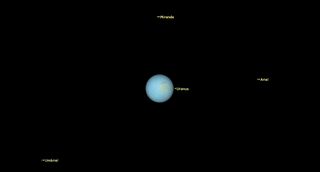
Uranus will reach opposition on Nov. 17, making it an all-night target during November — especially in the late evening, when it will be highest and most clearly viewed in a backyard telescope or binoculars. On opposition night, Uranus will be closest to Earth for this year — at a distance of 1.73 billion miles, 2.78 billion km, or 155 light-minutes. Uranus' minimum distance from Earth will boost its brightness to magnitude 5.61. It will also appear slightly larger — showing a 3.8 arc-seconds-wide disk in telescopes for a week or so centered on opposition night. All month long, Uranus' small, blue-green dot will be moving slowly retrograde westwards through western Taurus — followed across the night sky by the bright Pleiades Cluster a palm's width to Uranus' left (or 7 degrees to its northeast) and far brighter Jupiter, which will gleam 24 degrees to its lower left (or celestial east). On Nov. 15 the very bright full moon will shine several degrees to the upper right (or celestial north) of Uranus.
Neptune
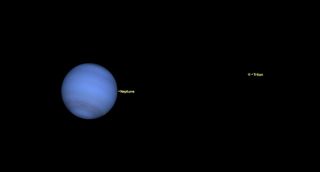
During November the distant planet Neptune will be observable during the evening as a blue, magnitude 7.8 speck among the stars near the Pisces-Aquarius border — below both the Great Square of Pegasus and the circle of stars that forms the western fish. Neptune's westerly motion will be slowing as it readies to complete its retrograde loop next month. The planet will be easiest to see while it is highest in the sky during early evening. Much brighter Saturn will be shining about 14 degrees to Neptune's right (or celestial west). In a telescope, Neptune's tiny apparent disk will span 2.3 arc-seconds, but larger telescopes can also show Neptune's large moon Triton. The bright, waxing gibbous moon will shine close to Neptune on Nov. 11.
Skywatching terms
Gibbous: Used to describe a planet or moon that is more than 50% illuminated.
Asterism: A noteworthy or striking pattern of stars within a larger constellation.
Degrees (measuring the sky): The sky is 360 degrees all the way around, which means roughly 180 degrees from horizon to horizon. It's easy to measure distances between objects: Your fist on an outstretched arm covers about 10 degrees of sky, while a finger covers about one degree.
Visual Magnitude: This is the astronomer's scale for measuring the brightness of objects in the sky. The dimmest object visible in the night sky under perfectly dark conditions is about magnitude 6.5. Brighter stars are magnitude 2 or 1. The brightest objects get negative numbers. Venus can be as bright as magnitude minus 4.9. The full moon is minus 12.7 and the sun is minus 26.8.
Terminator: The boundary on the moon between sunlight and shadow.
Zenith: The point in the sky directly overhead.
Night sky observing tips
Adjust to the dark: If you wish to observe fainter objects, such as meteors, dim stars, nebulas, and galaxies, give your eyes at least 15 minutes to adjust to the darkness. Avoid looking at your phone's bright screen by keeping it tucked away. If you must use it, set the brightness to minimum — or cover it with clingy red film.
Light Pollution: Even from a big city, one can see the moon, a handful of bright stars, and the brightest planets - if they are above the horizon. But to fully enjoy the heavens — especially a meteor shower, the fainter constellations, or to see the amazing swath across the sky that is the disk of our home galaxy, the Milky Way — rural areas are best for night sky viewing. If you're stuck in a city or suburban area, use a tree or dark building to block ambient light (or moonlight) and help reveal fainter sky objects. If you're in the suburbs, simply turning off outdoor lights can help.
Prepare for skywatching: If you plan to be outside for more than a few minutes, and it's not a warm summer evening, dress more warmly than you think is necessary. An hour of winter observing can chill you to the bone. For meteor showers, a blanket or lounge chair will prove to be much more comfortable than standing, or sitting in a chair and craning your neck to see overhead.
Daytime skywatching: On the days surrounding first quarter, the moon is visible in the afternoon daytime sky. At last quarter, the moon rises before sunrise and lingers into the morning daytime sky. When Venus is at a significant angle away from the sun it can often be spotted during the day as a brilliant point of light - but you'll need to consult an astronomy app to know when and where to look for it. When large sunspots develop on the sun, they can be seen without a telescope — as long as you use proper solar filters, such as eclipse glasses. Permanent eye damage can occur if you look at the sun for any length of time without protective eyewear.
Join our Space Forums to keep talking space on the latest missions, night sky and more! And if you have a news tip, correction or comment, let us know at: community@space.com.
Get the Space.com Newsletter
Breaking space news, the latest updates on rocket launches, skywatching events and more!
Chris Vaughan, aka @astrogeoguy, is an award-winning astronomer and Earth scientist with Astrogeo.ca, based near Toronto, Canada. He is a member of the Royal Astronomical Society of Canada and hosts their Insider's Guide to the Galaxy webcasts on YouTube. An avid visual astronomer, Chris operates the historic 74˝ telescope at the David Dunlap Observatory. He frequently organizes local star parties and solar astronomy sessions, and regularly delivers presentations about astronomy and Earth and planetary science, to students and the public in his Digital Starlab portable planetarium. His weekly Astronomy Skylights blog at www.AstroGeo.ca is enjoyed by readers worldwide. He is a regular contributor to SkyNews magazine, writes the monthly Night Sky Calendar for Space.com in cooperation with Simulation Curriculum, the creators of Starry Night and SkySafari, and content for several popular astronomy apps. His book "110 Things to See with a Telescope", was released in 2021.
-
Malcolm Hi MMohammad,Reply
Thank you for your gracious welcome via email, though I fear we are ‘light years’ away from each other (as my comment shows, if it stays and is not censored) when it comes to this Earth and the Universe in which we live. I am no expert but each to their own beliefs.
Regards,
Malcolm -
Skyguy712 Reply
so much cap like if they don't exist then it's all most impossible for the universe to exist, i have a theory of the big bang, the white hole theory, i believe that a black hole had held gas and dust for millions of years and then it got older and older that it had died and spit up the dust and matter and gas and such, then it all collided making planets and suchcorey555 said:Black holes don't exist -
bwana4swahili So why the "Night sky, October 2021: What you can see this month" title in the newsletter. Have I been transported back to 2021??Reply -
COLGeek Reply
Corrected. Thank you.bwana4swahili said:So why the "Night sky, October 2021: What you can see this month" title in the newsletter. Have I been transported back to 2021??
